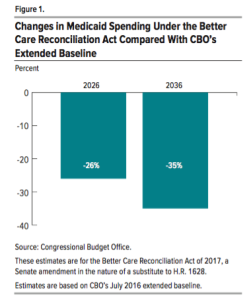Budget Office: Long-Term Medicaid Spending Would Drop 35% Under Obamacare Repeal Plan Image courtesy of Xavier J. Peg
As we mentioned in our coverage of the Congressional Budget Office’s review of the Senate proposal to repeal the Affordable Care Act, the ten-year focus of the CBO analysis could not fully illustrate the impact of Medicaid cuts that wouldn’t come until the latter half of that decade. Today, the CBO released a separate report that estimates what effect those cuts might have ten to twenty years from now.
 In the CBO’s initial report, it said that the Senate’s Better Care Reconciliation Act would lead to a 26% cut in Medicaid spending by 2026. Today’s analysis [PDF] predicts that this gap would continue to grow over the subsequent decade, reaching 35% by 2036.
In the CBO’s initial report, it said that the Senate’s Better Care Reconciliation Act would lead to a 26% cut in Medicaid spending by 2026. Today’s analysis [PDF] predicts that this gap would continue to grow over the subsequent decade, reaching 35% by 2036.
Opponents of the BCRA said the typical 10-year window for a CBO report was inadequate for the senate GOP proposal, since many of the long-term changes to federal involvement in Medicaid don’t begin until the latter portion of that window.
For instance, starting in 2025, the BCRA would change how the government calculates its per-person spending caps for Medicaid. The new formula, which ties growth the the cost of consumer goods rather than, as the House proposed, the cost of medical care, will mean slower spending growth for Medicaid in the long run, but just how slow was unknown. The CBO report gives us a first estimate of that long-range effect.
Earlier this week, President Trump attempted to counter reports of Medicaid cuts by posting this graph on Twitter that shows Medicaid spending projected to still continue through 2026:
However, as Vox.com quickly pointed out, the actual effect of the GOP proposal is only shown when you show where spending would be under current law:

credit: Vox.com
Medicaid is a joint program of the federal and state governments, and decreases in federal spending will likely mean shifting more of the financial burden to states.
The CBO analysis notes that states will have to decide “whether to commit more of their own resources, cut payments to health care providers and health plans, eliminate optional services, restrict eligibility for enrollment,” and that “Over the long term, there would be increasing pressure on more states to use all of those tools to a greater extent.”
Additionally, while CBO does not provide specifics, it expects that Medicaid enrollment would continue to drop after 2026, meaning an even larger number of Americans would likely be without healthcare. The 10-year analysis predicted that the BCRA would result in 22 million people going without insurance who would otherwise be covered under the current law, with 15 million of those being people who would have otherwise been eligible for Medicaid.
Medicaid currently covers nearly 70 million Americans, paying for about half of all childbirth in the U.S. and covering the majority of nursing home stays, in addition to providing healthcare for low-income families and the disabled.
Want more consumer news? Visit our parent organization, Consumer Reports, for the latest on scams, recalls, and other consumer issues.

